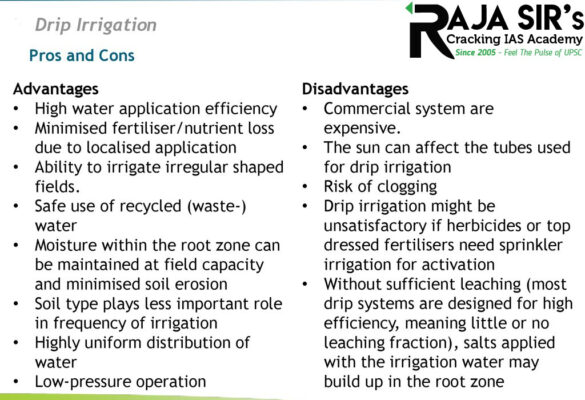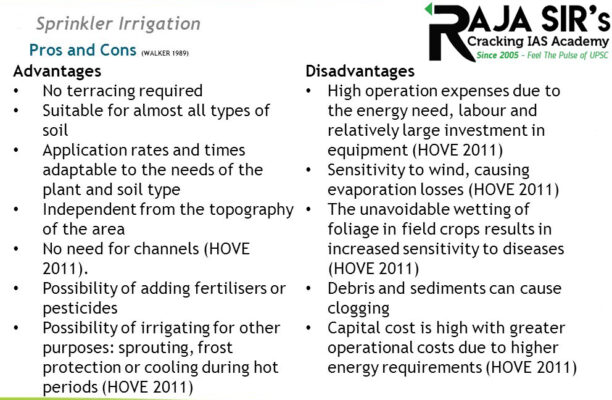- Home
- Prelims
- Mains
- Current Affairs
- Study Materials
- Test Series
 EDITORIALS & ARTICLES
EDITORIALS & ARTICLES
Micro-irrigation in India: bottlenecks and realities
Water is a scarce natural resource and the major requirement in the agricultural sector. The efficient use of available water forirrigation is a major challenge. Technological innovations such as micro-irrigation play an essential role in water-resource management.
Despite several benefits and widespread acknowledgement of the critical role of micro-irrigation in the sustainability of Indian agriculture, the industry that provides the wherewithal for it, is currently struggling to survive.
Price controls and bureaucratic delays in scheme enrolment, lack of field reviews and the delays in reimbursement of subsidies, etc, have pushed this industry to the brink of collapse despite its importance.
Water Availability & Micro-Irrigation in India

 Challenges Faced by Micro-Irrigation Industry
Challenges Faced by Micro-Irrigation Industry

- Declining Water Availability: India first entered the league of water-deficient countries in 2011.
- India’s per capita water availability is estimated at 1,428 kilolitres per year.
- A nation with annual water availability of below 1,700 kilolitres per head is considered water deficient.
- It has one of the fastest shrinking water pools among G-20 economies.
- India’s per capita water availability is estimated at 1,428 kilolitres per year.
- About Micro-Irrigation: It is a modern method of irrigation by which water is irrigated through drippers, sprinklers, foggers and by other emitters on the surface or subsurface of the land.
- Sprinkler irrigation and drip irrigation are the commonly used micro-irrigation methods.
- Significance of Micro-Irrigation:
- Micro-irrigation ensures water use efficiency as much as 50- 90%.
- Water savings in comparison with flood irrigation are to the tune of 30-50%, with an average of 32.3%.
- Electricity consumption falls significantly.
- Adoption of micro-irrigation results in savings on fertilizers.
- Increase in the average productivity of fruits and vegetables.
 Challenges Faced by Micro-Irrigation Industry
Challenges Faced by Micro-Irrigation Industry
- Slower Adoption Pace for Drip Method of Irrigation (DMI): The Task Force on Micro-Irrigation in India (2004) estimated India’s total drip irrigation potential stands at 27 million hectares.
- However, the area under drip-irrigation accounts for a mere 4% of gross irrigated area and about 15% of its total potential (2016-17).
- Moreover, the adoption of DMI is also concentrated only in a few States.
- Issues Associated to Irrigation-Related Schemes:
- Irresponsibility by State Governments: In most Indian states (with Gujarat and Tamil Nadu being the major exceptions), the scheme is operational only for a few months in a year.
- Despite the availability of funds, scheme applications are processed only at the end of a financial year, done typically to achieve pre-set targets in what is famously known as the ‘March rush’.
- As a result of this narrow window, only a handful of farmers can apply.
- Delays in the Reimbursement of Subsidies: Unlike other subsidies that are directly transferred to beneficiaries, those for installing drip irrigation systems are transferred to vendors only after due diligence.
- There is no fixed timeline for the inspection and testing of the installed system for transferring subsidies.
- Irresponsibility by State Governments: In most Indian states (with Gujarat and Tamil Nadu being the major exceptions), the scheme is operational only for a few months in a year.
- Financial Difficulties: The farmers often face difficulty in getting necessary support from financial services.
- It was reported that a lower adoption rate for micro-irrigation was due to the reduction in budget during the period 2013-16.
- Availability of Power: The main input for an irrigation system is energy, and for large scale projects, only electricity is a viable source which, despite having respective welfare schemes in place, is still beyond the reach of every farmer.
- Role of Administration: Setting a timeline for each stage, from an application by a farmer to the execution and payment disbursement and strengthening the government’s monitoring mechanism by insisting on a periodic review of applications, approvals, work orders and actual installations.
- Deploying direct benefit transfers for subsidy sums for micro-irrigation to go straight into the bank accounts of farmers.
- Also, farmers should be made able to avail the benefits of such welfare schemes in accordance with their crop cyclesor sowing patterns.
- Expanding the Scope of Micro-Irrigation: The capital cost required for the drip-irrigation method should be brought down substantially.
- A special subsidy programme may be introduced for water-intensive crops like sugarcane, banana and vegetables.
- A differential subsidy scheme for water-scarce and water-abundant areas can also be introduced.
- Currently, water from surface sources (dams, reservoirs, etc) is not used for DMI. A share of water from each irrigation project can be allocated only for DMI.
- A special subsidy programme may be introduced for water-intensive crops like sugarcane, banana and vegetables.









 Latest News
Latest News General Studies
General Studies